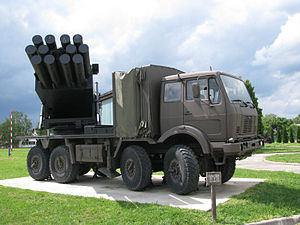Loading AI tools
Self-propelled multiple rocket launcher From Wikipedia, the free encyclopedia
The M-87 Orkan (from Serbian: оркан, lit. 'hurricane') is a Yugoslav fully automated self-propelled multiple rocket launcher. The generic M-87 project was configured with 12 launch tubes mounted on a FAP 2832 truck. It has a range of about 50 to 120 km, with the ability to deliver warheads, anti-tank and anti-personnel mines. The production of Orkan M-87 ceased in the early 1990s due to breakup of Yugoslavia.
| M87 LRSV | |
|---|---|
 Former Croatian M87 Orkan in Museum | |
| Type | Self-propelled multiple rocket launcher |
| Place of origin | Yugoslavia |
| Production history | |
| Designer | Military Technical Institute[1] |
| Specifications | |
| Mass | 32t |
| Length | 9 m (29 ft 6 in) |
| Width | 2.64 m (8 ft 8 in) |
| Height | 3.84 m (12 ft 7 in) |
| Crew | 5 |
Main armament | 262 mm x 12 Orkan ll x 4 |
| Engine | diesel |
| Maximum speed | 80 km/h (50 mph) |
Development started as a joint Yugoslav and Iraqi project under the name of KOL-15 with professor Obrad Vučurović as a concept designer and chief engineer on the project.[1] In early talks with Iraq, Yugoslavia offered two options:[2]
Iraq chose the first option as did Yugoslavia.
At the start of development, two prototypes were built: one for Yugoslavia and one for Iraq. In accordance with requests from purchasers, rockets were developed with cluster warheads.
According to the chief operating officer of the Artillery department of Military Technical Institute professor Obrad Vučurović,[3] Orkan was never a copy of any previous designs. The Yugoslav doctrine when developing the system was based on the premise that countries who copy designs are at least five years behind those who have the weapons developed.[2]
One battery[4] of M-87 Orkans consists of:
The FAP 2832 vehicle with its base platform is fitted with a central tyre pressure regulation system which is operated by the driver from within the cab, and to provide a more stable firing platform. Four stabilisers are lowered to the ground by remote control, one at either side to the rear of the second roadwheel and two at the very rear. When travelling, the launcher is traversed to the front and the whole launcher is covered by a tarpaulin cover with integral bows.
The rocket is 4.6 metres long and it is packed in a glass-ceramic housing and transported by vehicle. Rockets are reloaded by the FAP 3232 with a built-in crane. The rocket speed is 1000 m/s. Rockets with extended range are 4.88 m long and weigh 404 kg. A battery of 4 launchers with 16 barrels and 192 rockets can cover a target area of 3–4 km².[5]
The following types of rockets are known:[5][6][7]
Some of the rockets are no longer in production.
Unique features at the time of introduction (1987) when compared to other MRLs operational at the time include:[5][8]
According to Obrad Vučurović,[3] Orkan's main feature was the ability to disperse anti-tank or anti-personnel mines from 5 to 50 km from the firing location.

There were a few modifications of Orkan M-87:
In 1990s Turkey faced USA reluctance to share modern defense technology. In order to have domestic supply of multiple rocket launcher rockets and domestic launchers Turkey used reverse engineering and shortcuts in order to develop its own versions. In order to have a supply of 227mm rockets they reverse engineered M270 Multiple Launch Rocket System M26 rocket under project designation SAGE 227.[11] For continuing work on development of domestic MRLS Turkey obtained Orkan M-87 documentation, launcher and rockets from Bosnia and Herzegovina's "Bratstvo Novi Travnik" factory in 1995. They used them for development of a domestic 260mm rockets and launcher thus shortening development for more than 5 years. First launches of new 230 and 260mm rockets respectively based on 227 M26 and 262 Orkan rockets produced in Turkey from Orkan M-87 launcher were conducted in April 1999.[12][13]
In May 1995, the Republic of Serbian Krajina used M-87 Orkan to attack Zagreb after Croatian forces captured territories previously occupied by Serbian forces.

Seamless Wikipedia browsing. On steroids.
Every time you click a link to Wikipedia, Wiktionary or Wikiquote in your browser's search results, it will show the modern Wikiwand interface.
Wikiwand extension is a five stars, simple, with minimum permission required to keep your browsing private, safe and transparent.